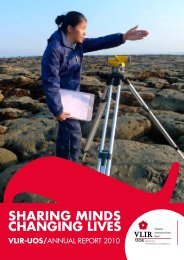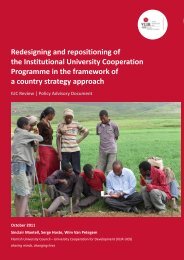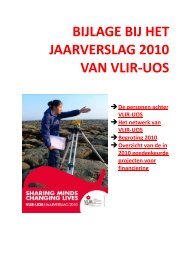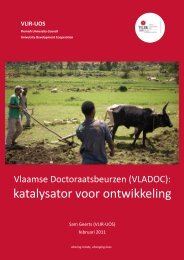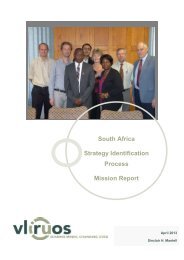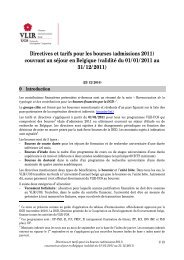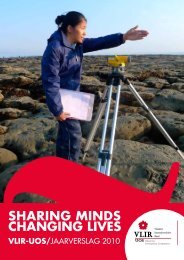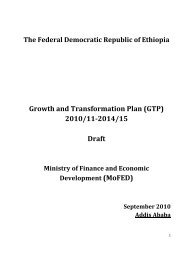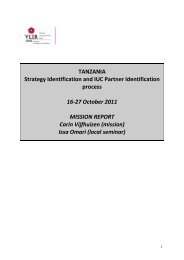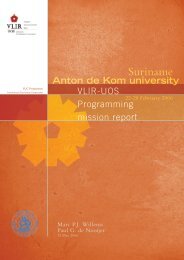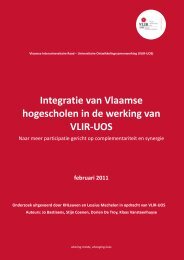Education Sector Development Program - VLIR-UOS
Education Sector Development Program - VLIR-UOS
Education Sector Development Program - VLIR-UOS
Create successful ePaper yourself
Turn your PDF publications into a flip-book with our unique Google optimized e-Paper software.
<strong>Education</strong> <strong>Sector</strong> <strong>Development</strong> <strong>Program</strong> IV<br />
The education sector,<br />
as producer of a<br />
responsible, productive,<br />
democratic and<br />
responsive work force<br />
for the economy, should<br />
be actively involved in<br />
this call for prevention<br />
of drugs and substance<br />
abuses.<br />
The physical and mental agony of withdrawal is<br />
significant.<br />
Families who live with drug abusers also<br />
experience many of the effects of drug and<br />
substance abuse. These include, among<br />
others, increased school dropout rates,<br />
and increased violence. Drug abuse is an<br />
expensive habit, and has bankrupted many<br />
families. There are high costs of treatment<br />
and rehabilitation incurred in handling the<br />
health and social consequential problems<br />
due to drug abuse.<br />
It is hard to quantify the direct cost and<br />
implications of drug and substance abuse<br />
in the country. However, the increase in<br />
the number of street families, road traffic<br />
accidents, and work related accidents and<br />
reduced productivity are some of the costs of<br />
drug and substance abuse. The widespread use<br />
of substances is having debilitating effect both on<br />
members of the economically active and also on<br />
the school age populations.<br />
Use of alcohol and drugs poses increased risks<br />
in the transmission of HIV. A number of studies<br />
have indicated the relationship between alcohol<br />
use and increased risky sexual behavior.<br />
At present, there is a legal narcotics controlling<br />
body on matters of drug and substance abuse<br />
i.e. “Drug Administration and Control Authority/<br />
DACA” established by proclamation number<br />
176/1999. Its mandate is limited to provision of<br />
special licenses to import, export, manufacture,<br />
possess or store narcotic drugs or psychotropic<br />
substances and related.<br />
The control of drug and substance abuse requires<br />
multi- sectoral approach and concerted efforts of<br />
government organizations, NGOs, communities<br />
and others.<br />
So the education sector, as producer of a<br />
responsible, productive, democratic and<br />
responsive work force for the economy, should<br />
be actively involved in this call for prevention<br />
of drugs and substance abuses. The different<br />
forums of educational processes (General<br />
<strong>Education</strong>, TVET and Higher <strong>Education</strong>)<br />
present ample opportunity for education on<br />
drugs and substance abuse/DSA control for<br />
teachers and students at all educational<br />
levels. It is strongly perceived that school and<br />
HEI gates and /or their vicinities are vulnerable<br />
spots to DSA. It is also a well-established fact<br />
that the youth in school or out of school is<br />
highly susceptible to be victimized by drug and<br />
substance abuse/DSA. Therefore, schools and<br />
HEIs are opportune facilities to institute strong<br />
and effective drug and substances control<br />
programs. Hence, the education sector should<br />
collaborate with DACA and other agencies<br />
as well as establish anti-narcotics units to<br />
coordinate drug and substances abuse control<br />
activities, which will minimize dropouts,<br />
repetitions and violence in schools and higher<br />
education institutions/HEIs.<br />
Main challenges<br />
• Substance abuse is a significant<br />
risk for many youngsters.<br />
• Linkage between substance abuse<br />
and school drop-out.<br />
• Little attention at present within<br />
the education system to address<br />
this issue<br />
2. Expected program outcomes<br />
❚<br />
❚<br />
❚<br />
Governance structure for drug<br />
and substances abuse control and<br />
prevention established at all levels<br />
Awareness raising programs on<br />
drug and substanceabuse prevention<br />
conducted<br />
Drug and substances abuse<br />
prevention mainstreamed<br />
Key outcome indicators/targets<br />
Drug and substance abuse units will be<br />
established at all levels (MOE, REB, HEIs, WEOs<br />
and schools)<br />
MOE will be actively involved in the Inter<br />
Ministerial and Technical Committee which is<br />
established at a federal level to prevent drug<br />
and substance abuse<br />
Awareness programs will be conducted on the<br />
current status of drug and substance abuse and<br />
on the preventive measures to be taken<br />
Main streaming strategy for drug and substance<br />
abuse will be developed in collaboration with<br />
DACA and other relevant agencies<br />
Drug and substance abuse prevention will be<br />
main streamed<br />
DSA prevention will be included in the next<br />
revision of curricula<br />
3. Policy and Strategies<br />
Ethiopia has demonstrated its commitment to<br />
international communities to fight drug abuse<br />
by ratifying Conventions: single convention on<br />
narcotic drugs, 1961 as amended by the 1972<br />
protocol amending the single convention on<br />
narcotic drugs, 1961; convention on psychotropic<br />
substances 1971; and United Nations convention<br />
against illicit traffic in narcotic drugs and<br />
psychotropic substances, 1988.<br />
It is stated, in the health policy issued in 1993<br />
by the then Transitional Government of Ethiopia,<br />
88



